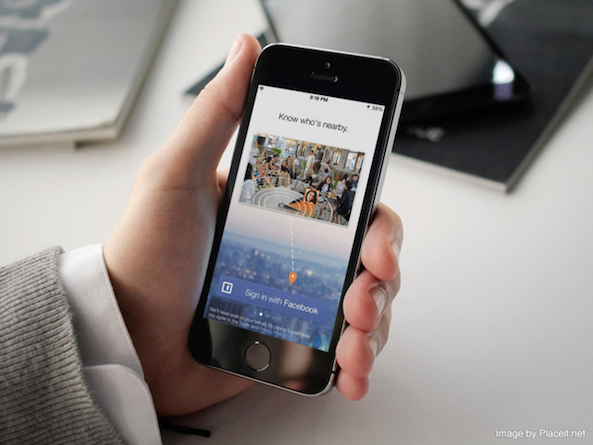
Social media is now a social norm. College students procrastinating homework by connecting with others on Facebook started a massive revolution. First, social media was limited through Facebook to only students with college email addresses. Quickly, Facebook became an open platform for everyone to enjoy.
Twitter took fire and is still gaining in popularity with all age groups. However, unlike Facebook, Twitter users are less scared about their grandmother stalking them down. Of course, there is Foursquare, letting users check in to places around the globe. The first platform to truly push geolocation as a primary factor, Foursquare rustled a few feathers, but like all social media, has become quite mainstream, with users less frequently scared to post their whereabouts.
There are many other less mainstream social media platforms and new ones arise everyday. However, not many new services are instantly successful. SocialRadar, launching today, could be the new major social media platform, destine to hang in the ranks of Facebook and Twitter, or at least complement them nicely…
The next platform
As a brief introduction, SocialRadar is an app to provide real-time information about those around you. Primarily, that information is location based. Secondarily, data about those around you is displayed in a usable feed. As a quick example, you walk into your favorite restaurant downtown and open SocialRadar. Instantly, you will be provided a list of your social contacts in your surrounding area, within a certain range. The range can be expansive or narrowed to only those users who are in the same restaurant. A scrollable menu provides the names and profile cards of those in the set distance, giving more information once the cards are tapped.
Sound scary, freaky, terrifying? When I first received information about SocialRadar, I felt all of those things. Keeping an open mind, I was able to schedule an interview with SocialRadar’s founder Michael Chasen during CES 2014. After a quick, private interview and demonstration, my Big Brother fears and false assumptions were assuaged.
Using SocialRadar requires users to, at least, connect with Facebook, something I am particularly against. In fact, I often immediately delete apps that require social media login for usage. Bear with me. After logging in with Facebook, other social media platforms may be and should be connected for the most useful experience. Adding Foursquare, Twitter, Google+, Instagram, and LinkedIn, allows SocialRadar to glean information from all sources.
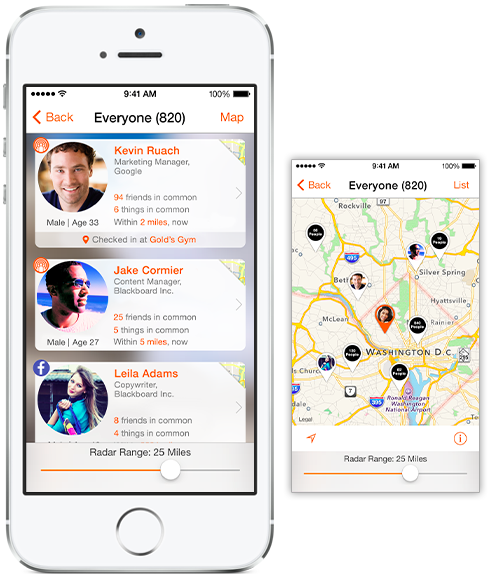
SocialRadar allows users to add personal contact information by building an internal profile, but adding the addition social media platform provides a more holistic amalgam of information. The app then scans connected platforms for other users’ information, both profile data points and, most importantly, geolocation tags. When operating SocialRadar, users can then view who is near them, within a scalable distance, and find out more about them by tapping their SocialRadar compiled contact card.
SocialRadar contact cards are combed information about people to whom I am connected through one or more social media platforms. If someone looks at me, for example, they would be able to see what music I like (Facebook), my employer and past jobs (LinkedIn), where I went to school (Facebook), my tweet from this afternoon (Twitter), and/or a foodie pic from the local restaurant (Instagram). Additionally, since I also use SocialRadar and have the location sharing feature turned on, users could tell where I am, instantly. It is like having Find My Friends turned on for anyone you are connected with through social media.
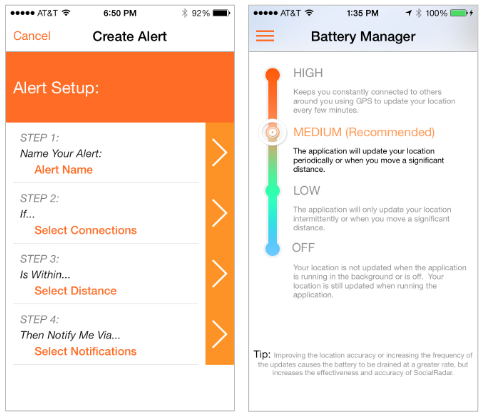
Where SocialRadar becomes more interesting, is its ability to find social media contacts who do not currently use SocialRadar. If you tweet with a location turned on or check-in somewhere with Facebook or Foursquare, SocialRadar will pull that data and provide users with that location. Since other social media platforms are not instant location entries, SocialRadar would provide the last known location and time reference. Something similar to: @jim_gresham tweeted one hour ago that he was at Wendy’s and that is x miles away from your current location.
Taking things a step further, SocialRadar will allow users to set alerts for conditional situations. It is like building an IFTTT recipe. “If,” then choose a connection, “someone from iDownloadBlog,” select distance, “is within 25 miles,” then, “notify me via notification.” This could be a great feature for those looking to meet business contacts or friends in a particular metro area. Headed out for the night? Use SocialRadar to find out where your contacts are already gathered.
Location sharing is your choice
SocialRadar seemed terrifying by the description but not once I started really thinking about how we share information. Twitter is my most used social media platform and, sometimes, I use geopinned tweets to let followers know where I am at a specific time, most notably, earlier this month at CES. I chose to send my location, freely providing my information to anyone that intentionally ran across my tweet. Followers could use that data to find me instantly, assuming I have not moved from the tweeted location. All SocialRadar is doing is finding that tweet and providing the location along with a stream of other user data.
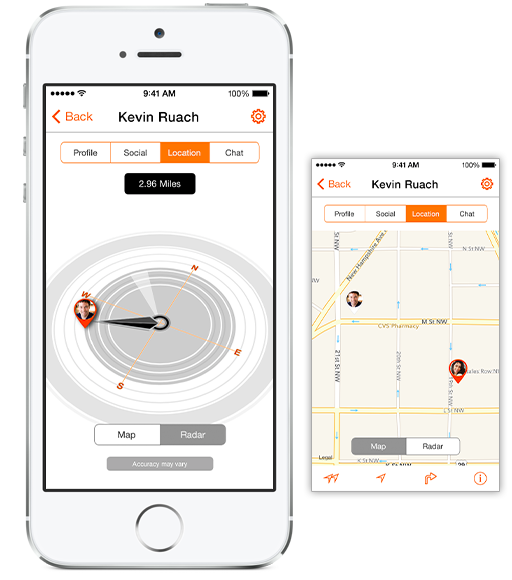
Using Foursquare is similar. People choose to actively provide their information to their followers by checking into locations. Facebook is the same, even letting users check in other people. Again, SocialRadar just compiles information that is already there and was shared freely.
The difference is how people use SocialRadar. Anyone with the app chooses how to share their location. The intended use is for continuous geolocation sharing, with battery life in mind. If you are using SocialRadar, you are accepting that other people connected to you can find you, anytime, anywhere. Of course, there are tiers of privacy built into SocialRadar and the app makes no intention to hide the sharing levels.
There is something intimately audacious about SocialRadar’s intentions, to share users’ locations in a constant stream and locate other people, who do not even have SocialRadar profiles. But, taking a step back, the individual people have all, at one time or another, decided, on their own volition, to share their location. SocialRadar is simply a tool to help cull publicly available information into a constant stream of easily usable data. At the same time, it looks very elegant, wrapped in a pleasing UI, which even changes backgrounds depending on the nearest US city.
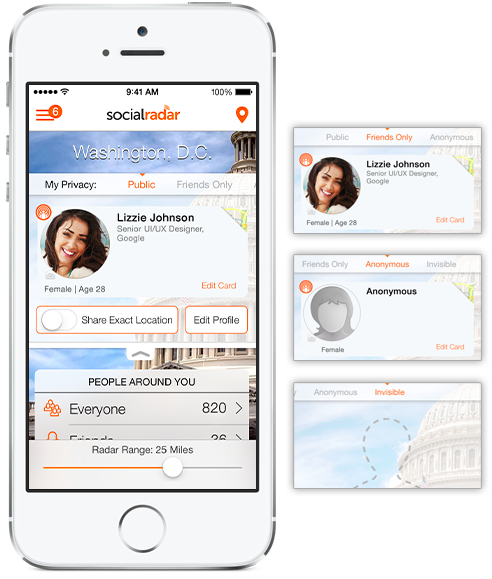
Will I continue using SocialRadar now that it is past the beta stage? I believe I will drudge on into the future of geolocation madness by staying connected for a while. As more people begin to utilize the service, I may turn up the restriction on my sharable data, but then I am missing the point. SocialRadar is designed to connect people with whom I am already connected.
Why will this platform become the new standard? SocialRadar is positioned as the parent to all other location based social media platforms. Liquifying huge data chunks across all other profiles and flowing them into one continual stream of user profile data is incredibly useful. Interacting with others can be accomplished through one new gold standard, SocialRadar. And, I might find out my old buddies are just a few blocks over. Knowing where my friends are located on a Friday night or professional contacts at a national conference has endless opportunities. Did you miss a chance to catch up with a buddy? Or, is a connection nearby that could help you find the next career move?
http://www.youtube.com/watch?v=Gmz-9VOUI5c
SocialRadar is not a creepy stalker app of the future, which is what people will initially believe. What those terrified people are not considering is the power of having your contacts rolled into one app, with the ability to help you bump into people on a daily basis. This app could change the way people interact. SocialRadar could become the new standard in social media. However, this acceptance will not be overnight. Acceptance will come as more people decide it is beneficial for people to connect, thus lowering their hesitation to share location driven data. Give SocialRadar time. It will become more than we can predict on launch day. But, mark my words, this app is going to cause a great amount of chatter. With an open API, it will even begin to interface with other apps, further extending its reach.
You can download SocialRadar for free. Weigh-in through the comment section below. Can you see the opportunity or are you shocked at the intentions?